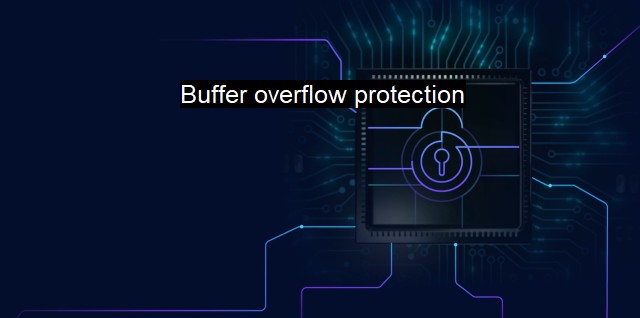What is Buffer overflow protection?
Buffer Overflow Protection: A Vital Component of Antivirus and Cybersecurity Software for Guarding Against Malicious Code and Cyber Attacks.
Buffer overflow protection is an important aspect of cybersecurity and antivirus software, aimed at preventing or minimizing the risk of buffer overflow attacks. In the terrain of cybersecurity, such protection is crucial as it safeguards computing systems from threats that attempt to fill buffers beyond their capacity, leading to adverse scenarios, including system crashes or allowing unauthorized access to critical data stored on a system.To understand buffer overflow protection, it's essential to first comprehend what buffer overflow is. A buffer is a temporary storage space within a system’s memory, used to store data temporarily during the operation of a software or an operating system. The sizes of these buffer spaces are predetermined and they could only accommodate a set amount of data. when more data than a buffer's capacity is inputted (either mistakenly or intentionally), this excess data spills over to adjacent buffer spaces, causing disruptions, which is what is termed as a buffer overflow.
Buffer overflow could lead to numerous deleterious effects. Principally, it allows malicious hackers or cybercriminals to manipulate a system's operations or initiate unauthorized actions like granting themselves administrative access. When buffers overflow, they overwrite adjacent memory locations, often causing system errors and crashes. Intruders can exploit this to inject malicious codes which would execute unintended commands or initiate harmful activities.
Guarding against such threat, buffer overflow protection acts as a preventive measure. Its fundamental function is to manage and ensure that data inputs align with buffer space capacities, thereby preventing the overspill of data. It scrutinizes inputs before they are processed, and in situations where data input exceeds the buffer's capacity, the system either refuses the excess data or shuts down processes temporarily pending when the surplus is managed.
Buffer overflow protection mechanisms add several control checks that prove effective in curbing buffer overflow attacks. One key strategy is the introduction of an abstract layer between the application and the system’s memory. This layer serves as an active policing force—checking the quantity, source, and type of data input, and ensuring only secure and legitimate data get across.
Among numerous protective strategies, software applications have containment or isolation methods where different processes are carried in multiple isolated buffers, preventing a spillover from one buffer from affecting another. This strategy ensures an effective separation of data and processes, limiting any compromise to a specific buffer rather than the entire system.
Also, non-executable buffer zones are adopted by these protections where only data can be stored, and sets of executable instructions are disallowed. Data writing privilege is taken away from certain memory partitions. This means malicious hackers cannot execute codes or change program instructions from buffers, reducing unauthorized access to the system and limiting other damages.
Another vital strategy involves bounds checking. In this, any attempt to write data that will exceed the storage capacity of a particular buffer is promptly halted. Values are also assigned to areas around buffers to keep track of data overflow. Once these values or canaries are altered, it immediately indicates an overflow, and offending processes can simultaneously be halted avoiding ripe scenarios for exploits.
These methods have become common features in many contemporary cyber-security solutions, antivirus software, and modern operating systems, which prioritize safety by preventing such overflow scenarios and addressing them actively in event of occurrences. Built-in buffer overflow protection features offer developed processes that encapsulate cyber security countermeasures and resistance protocols that checkmate potential cyber-attacks via manipulative overflows.
In the hyper-connected digital landscape where user data and systems vulnerability are explored by cybercriminals, buffer overflow protection is a critical pioneer, holding forte in the wider ambit of cyber security, forming a structural wall in safeguarding data, systems integrity and private access against invasive overflow exploits. The sophisticated approaches it employs ensure that system security isn't breached and private data remain inaccessible. With it, users and enterprises alike can use their systems with an assurance of security, making interactions within the digital realm seamless and much safer.

Buffer overflow protection FAQs
What is buffer overflow protection?
Buffer overflow protection is a security mechanism that prevents malicious code from exploiting a buffer overflow vulnerability in a program by monitoring and limiting the amount of data that can be written into a buffer.Why is buffer overflow protection important in cybersecurity?
Buffer overflow vulnerabilities are a commonly exploited type of security flaw that can enable attackers to execute malicious code on a system. By implementing buffer overflow protection, cybersecurity teams can prevent these types of attacks and keep systems secure.How does antivirus software use buffer overflow protection?
Antivirus software can use various techniques for buffer overflow protection, such as stack canaries, address space layout randomization (ASLR), and data execution prevention (DEP). These techniques help prevent memory corruption and stop malicious code execution.Can buffer overflow protection be bypassed?
While buffer overflow protection can significantly improve system security, it is possible for attackers to find ways to bypass these protections. However, implementing multiple layers of protection and staying up-to-date with the latest security measures can make it more difficult for attackers to exploit vulnerabilities.| | A | | | B | | | C | | | D | | | E | | | F | | | G | | | H | | | I | | | J | | | K | | | L | | | M | |
| | N | | | O | | | P | | | Q | | | R | | | S | | | T | | | U | | | V | | | W | | | X | | | Y | | | Z | |
| | 1 | | | 2 | | | 3 | | | 4 | | | 7 | | | 8 | | |||||||